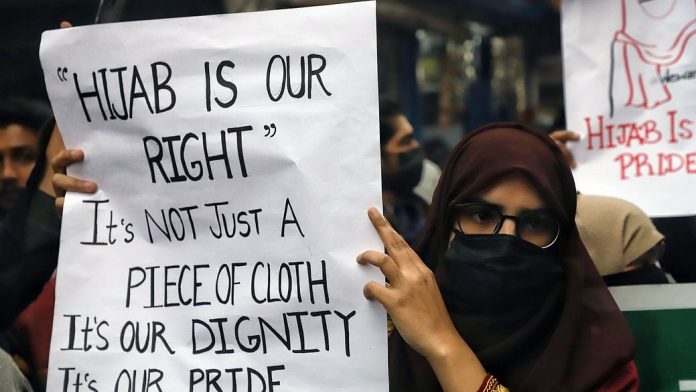
To discuss whether the hijab is essential or not, whether all Muslims wear the hijab or not, whether those who wear it do it out of choice or not: these questions are meant to divert the focus away from the real issue plaguing India: Hindu majoritarianism.
Irena Akbar | TwoCircles.net
“No woman in my family has ever observed the purdah.”
“No one in my family wears the hijab or the burqa”.
Do these lines sound familiar? Most likely, you’ve read them in liberal Muslims’ declarations of “support” on social media for the right of Muslim girls in Karnataka to wear the hijab to school/college. After explaining their own family’s relationship with the hijab/purdah, they write “but I support the right of Muslim girls to wear the hijab”.
What motivates Muslim liberals to publicly distance their individual selves from the hijab or burqa or other Islamic symbols of modesty? And why should this public distancing precede their support for the right to wear hijab? Does this qualified support have a larger, societal purpose, or is it confined to maintaining/reinforcing individual images of Muslim liberals?
The hallmark of Muslim liberals has been to stand apart from the more visibly religious, common “mass” of Muslims. By publicly detaching themselves from symbols that evoke the Islamic faith or identity like the hijab or the topi, the Muslim liberal welcomes “plaudits” like “progressive Muslim”, “forward-thinking Muslim” and “you are unlike other Muslims” from the liberal Hindu elite. For the liberal Muslim, such Islamophobic comments count as “personal compliments”.
Hence, “no woman in my family wears the hijab but I support the right to wear it.” In other words, “I am with you but not of you. I am standing with you, but at a distance.”
If the Muslim liberal is a public figure, it wouldn’t be unfair to infer that he/she is irresponsible at best and selfish at worst, his/her concern for personal image preceding concern for the community. A public figure should be conscious that his/her statements can influence the narrative at play, and hence should weigh his/her words before saying/writing them. This can’t be emphasized enough when systemic Islamophobia runs large. Author and journalist Ghazala Wahab wrote a Twitter thread that dismissed the agency of the Karnataka girls in choosing to wear the hijab and questioned whether Muslim men/boys are required to sport Muslim identity. Muslim teenager Junaid was lynched on a train in Delhi-NCR because he wore a skullcap in 2017. Mohsin Sheikh was killed by Hindutva goons in Pune in 2014 because his beard made him look “too Muslim”. One just has to Google for other examples. Former AMU vice-chancellor Zameeruddin Shah said in a TV interview that “no woman in his family wears the hijab” and that there is “no injunction for the burqa” in the Quran — incorrect, because, in Quran 33:59, Muslim women are instructed to draw an “outer garment” when they step outside. A chador, or shrug, or burqa is an outer garment.
Muslim liberals who are ordinary citizens, however, may not be aware that they are playing into Islamophobia. They are probably operating out of fear of losing their Hindu friends if they vocalize uncomfortable truths. Hence they offer an unnecessary, personal apology for the hijab by clarifying that they or their family doesn’t wear it.
Such apologetic riders are not only unnecessary, but they are also counter-productive to the cause of the hijab-wearing Muslim girls. Instead of adding value or strength to the cause, they weaken it. The Muslim girls of Karnataka are fighting to wear the hijab as an intrinsic/integral/essential part of their Islamic faith. The Muslim liberal, by publicly stating her (or his family’s) choice in not wearing it, is strengthening the misplaced public perception that the hijab is an optional aspect of Islam. One has to read the first, 30th and 31st verses of Surah Al-Nur chapter of the Quran to know that the hijab is a mandatory aspect of Islam. A liberal Muslim might not adhere to this aspect out of choice or ignorance, but for her/him to make a big deal out of it publicly will affect how the public, the media, and the Karnataka High Court view the Muslim girls’ right to wear the hijab. Each one of us has a responsibility to ensure that we don’t play our part in denying access to education to Muslim girls. Just for approval by the Hindu majority, should Muslim liberals throw their sisters in Karnataka under the bus?
Finally, and most importantly, the anti-hijab movement in Karnataka is not about hijab per se, but a part of the larger Hindutva agenda. Like beef and love jihad, CAA and Covid, the hijab is the latest excuse by the state to corner and demonise Muslims, and this time, to intimidate them into giving up their rights and identity. We saw it in the viral video where a Muslim teacher had to take off her abaya and hijab at the gate of her institution in full public view, even though the hijab ban doesn’t apply to teachers.
To discuss whether the hijab is essential or not, whether all Muslims wear the hijab or not, whether those who wear it do it out of choice or not: these questions are meant to divert the focus away from the real issue plaguing India: Hindu majoritarianism. The media is predictably toeing the state’s agenda. The least the Muslim liberals should do is not aggravate it with their unnecessary stand on the hijab.
Irene Akbar is an entrepreneur and a freelance writer. She tweets at @irenaakbar

